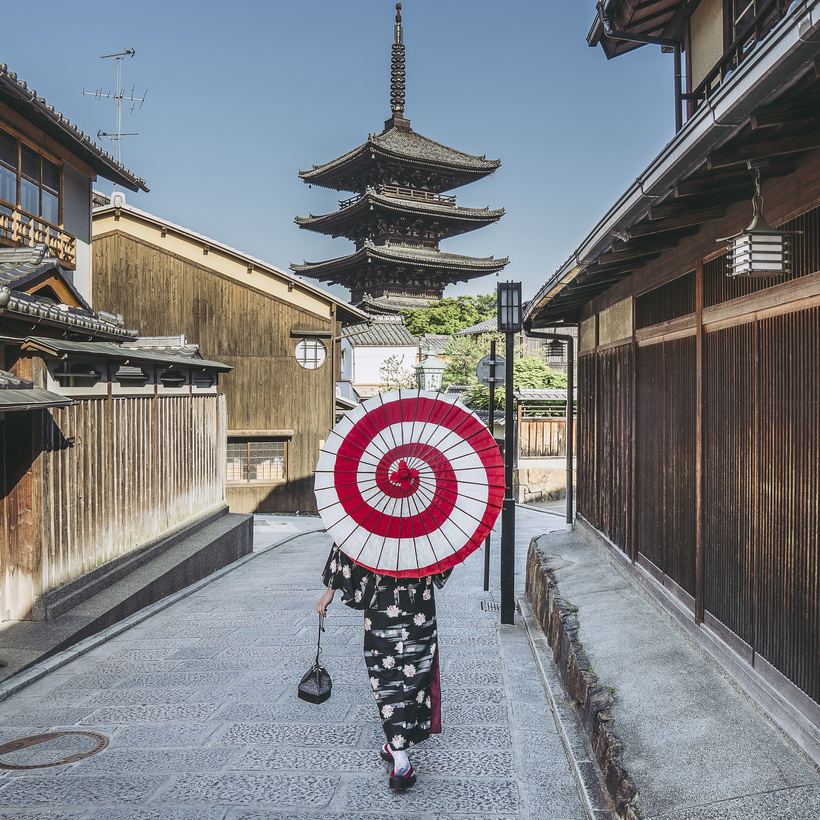On February 18, 2020, I landed in Kyoto for a four-day vacation. The world was beginning its coronavirus-induced shutdown, and as I walked through the city, I struggled to adjust to wearing the mask I’d been handed on my flight by a bowing Shinkansen seatmate.
During my stay, I had the exquisite illusion of having the ancient city to myself: empty temples, empty tables. With almost all Westerners going or staying home and Chinese tourists—who were said to have accounted for almost 70 percent of travelers in one of Japan’s most popular destinations—barred from entering, the only language I heard was Japanese.

It reminded me of my childhood fantasy of being locked in a museum overnight, free to wander and linger and stare. Some streets were so still that you could dance in them, which my friend and I did.
When it was announced this past October that Japan would fully reopen to foreigners after two and a half years of coronavirus-necessitated closure, the tourism industry was fast off the starting block.
When I returned, exactly three years later, Kyoto had been reclaimed by its inhabitants. The “tourism pollution” had cleared. In the morning, locals were doing their shopping at the 700-year-old Nishiki Market. The NO PHOTOS and PLEASE DON’T EAT WHILE WALKING signs posted at almost every stall weren’t needed until well into lunchtime, when tour groups once again rendered the food market impassable.
The parking lot at the Golden Pavilion held only a few buses, waiting for uniformed students to return from their selfie-taking at the heritage site. Shopping streets in the historic district that had felt avoided by locals on my first visit were now populated only by them.

In addition to preserving its 2,000 temples and shrines over the centuries, Kyoto has also preserved its sense of self. Like New York, it is organized to delight a parallel population of paying guests, who are contained to a handful of areas in the city of over 1.4 million.
For the visitor, it can feel as though real life is happening elsewhere, either behind painted screens or in another part of town. On this trip, however, Kyoto felt re-wilded, its once weary citizens lured out by the calm.
That calm ended in mid-March as the cherry trees blossomed and Noma’s pop-up at Kyoto’s Ace Hotel began serving those blossoms fresh, salted, and more. (On a tour of the space, chef René Redzepi told me that when they had to push their opening date a few months because Japan hadn’t yet reopened, it was almost impossible to find hotels and housing for 100 people, comprising staff and their families: everything was booked or prohibitively expensive starting in late March.) Noma sold out 10 weeks of lunch and dinner seatings starting at approximately $830 per person in minutes.

Up until recently, first-time visitors tended to make Kyoto a day trip, or overnight from Tokyo, eager to see anything pre-1945. (Kyoto, which served as the capital of Japan from the eighth century until 1869, was untouched during World War II.) For a certain group, it was because Kyoto lacked high-end hotels. People would leave from, and quickly return to, the Park Hyatt or the Okura or, more recently, the Aman.
It can feel as though real life is happening elsewhere, either behind painted screens or in another part of town.
Now Kyoto has those properties and more, such as the Shinmonzen, designed by Tadao Ando and opened in late 2021 as the sibling to legendary London hotelier Paddy McKillen’s Villa La Coste, in Provence. Kyoto’s hotels, whether new or hundreds of years old, are another strong reason to spend more than one night. They’re part of what brought me back, and for a longer visit this time.

Open since November 2019, Kyoto’s new Aman is based on Japan’s ryokans, or inns. Ryokan visitors tend to spend a night or two immersed in subtle beauty, traditional craftsmanship, and generous gestures. From the in-room breakfast to the kaiseki dinner, each consisting of countless precious dishes, it is palpably clear that each course has a history and symbolism, each ingredient a mere blink of the season. (The kaiseki calendar lists 72.) For foreign visitors, being in Japan can feel like living on another planet. Staying in a ryokan transports you back several centuries, too.
While the Aman Kyoto wisely hews to the culture’s attention to detail and ritual, it allows guests more freedom than a ryokan. You can fill the Toyota-size hinoki tub yourself. You can marvel at the intentionality of the mossy stone path and hidden gardens at will. (The hillside property was purchased 20 years ago from the estate of a prominent kimono merchant who had intended to develop it as an obi museum before the fashions changed.) You can dine in your room or at a restaurant, and have your matcha whisked tableside in the Living Pavilion.

While the 79-acre property is in a slightly suburban area, it’s immersive enough to feel like the countryside, especially when you’re watching the steam from the onsen (hot spring) float toward the stars. While most five-star-hotel groups have a bland sameness that make you wonder if you’re in Aspen or Istanbul, this Aman exudes a sense of place.
At the Aman, I met an employee whose mother owned the legendary Hiiragiya ryokan, where I would sleep-slash-float for the rest of my trip. I wondered which way the energy was flowing: from the 205-year-old ryokan near the city’s center, or from Aman’s $3,000-per-night hinoki spaceship. Both are expert at coddling the coddled. For the high-paying guest, it’s merely a question of how much of the culture you want to participate in.

I was initially disappointed that the Tawaraya, the fabled ryokan across the street from the Hiiragiya, was closed for renovations until April. When I stayed there, in 2020, I came away re-strung, attuned to a new level of subtlety and order in design and living. No wonder Steve Jobs would go time and time again.
By the time I checked out of the Hiiragiya, I had been won over by the warmth and moments of wonkiness, such as an outdated, gourd-shaped device designed to help you turn out the lights while on the futon.
Ryokan rates include breakfast and dinner. On this visit, the latter was a godsend, as the restaurants I wanted to go to had booked up months ago, and unless you’re game to stumble into izakayas (pubs with good food), to an outsider Kyoto doesn’t give off walk-in vibes.
I was able to get only two reservations by asking multiple Japanese friends to go online. Thanks to a Chef’s Table episode featuring chef Yoshihiro Imai’s self-taught pizza-making, Monk had the most gaijin (foreigners) I’d seen all week, with 10 of the restaurant’s 14 seats taken by an international group happily pairing natural wines with the produce-focused omakase menu. The meal culminates in half of a pizza of one’s choice. I was torn between fresh nori and tiny baby sardines with soy, both with mozzarella.

The following night’s meal was at the deeply witchy Farmoon, a five-minute walk near the start of the Philosopher’s Path. After working at New York’s Blue Hill, chef Masayo Funakoshi returned to her native Japan to refine her approach to seasonal ingredients. The former artist’s profoundly personal food includes plenty of acid and olive oil, which you may crave toward the end of an umami-ballasted trip. (I also loved visiting Farmoon during the day for tea and lovely sweets.)
That last meal had been booked on my first stop in Kyoto, to see the ceramics gallerist Robert Yellin. In 2020, his gallery was in the living room of his 19th-century home, which had been built for an industrialist. That visit was the highlight of my stay. Not only is visiting the American expat something like an event (asked what drew him to Japan in 1984, he looked at me like I’d fallen off the roof and said, “Aesthetics”), he is a wise guide. He sent me to a nearby soba shop and temple that were invisible to search engines, and both were perfection.
Yellin is also an excellent matchmaker for those who collect antique and contemporary ceramics. He can lift the veil on the treasures of a notoriously impenetrable heritage site—or lift his phone to call his friend at the restaurant around the corner to see if she’ll squeeze you in. This sort of benevolent guide is really what it takes to begin to understand a city that would require a lifetime to explore.

For every overtouristed temple and selfie shrine, there are hundreds of treasures that locals keep for themselves. There are also magical places hiding in plain sight for those detached enough from their phones to see.
The last three years have given Kyoto back to its people, and they have paid a dear price for its beauty. To discover the city among them felt like a privilege, and so I followed the new rules for tourists—polite and well designed—that have been posted in high-traffic locales. And I was also careful not to speak too loudly or make any sudden gestures, lest I rouse them from this all-too-temporary dream.
Christine Muhlke, a former editor for The New York Times and Bon Appétit, is a co-author of Wine Simple, with Le Bernardin’s Aldo Sohm, and a co-author of Phaidon’s Signature Dishes That Matter. She is also the founder of culinary consultancy Bureau X and creator of the Xtine newsletter


